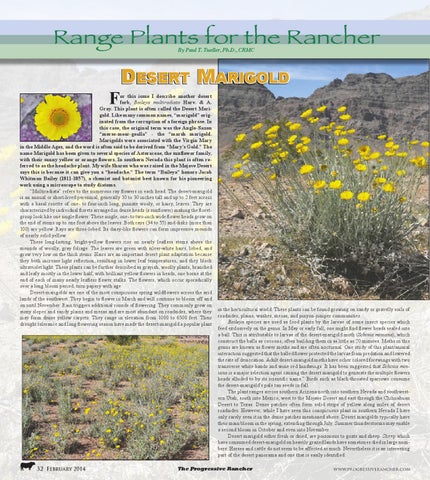Range Plants for the Rancher By Paul T. Tueller, Ph.D., CRMC
F
Desert Marigold
or this issue I describe another desert forb, Baileya multiradiata Harv. & A. Gray. This plant is often called the Desert Marigold. Like many common names, “marigold” originated from the corruption of a foreign phrase. In this case, the original term was the Anglo-Saxon “merse-mear-gealla” - the “marsh marigold. Marigolds were associated with the Virgin Mary in the Middle Ages, and the word is often said to be derived from “Mary’s Gold.” The name Marigold has been given to several species of Asteraceae, the sunflower family, with their sunny yellow or orange flowers. In southern Nevada this plant is often referred to as the headache plant. My wife Sharon who was raised in the Mojave Desert says this is because it can give you a “headache.” The term “Baileya” honors Jacob Whitman Bailey (1811-1857), a chemist and botanist best known for his pioneering work using a microscope to study diatoms. “Multiradiata” refers to the numerous ray flowers in each head. The desert-marigold is an annual or short-lived perennial, generally 10 to 30 inches tall and up to 2 feet across with a basal rosette of one- to four-inch long, pinnate wooly, or hairy, leaves. They are characterized by individual florets arranged in dense heads (a sunflower) making the floretgroup look like one single flower. These single, one- to two-inch wide flower heads grow on the end of stems up to one foot above the leaves. Both rays (34 to 55) and disks (more than 100) are yellow. Rays are three-lobed. Its daisy-like flowers can form impressive mounds of nearly solid yellow. These long-lasting, bright-yellow flowers rise on nearly leafless stems above the mounds of woolly, gray foliage. The leaves are green with silver-white hairs, lobed, and grow very low on the thick stems. Hairs are an important desert plant adaptation because they both increase light reflection, resulting in lower leaf temperatures, and they block ultraviolet light. These plants can be further described as grayish, woolly plants, branched and leafy mostly in the lower half, with brilliant yellow flowers in heads, one borne at the end of each of many nearly leafless flower stalks. The flowers, which occur sporadically over a long bloom period, turn papery with age. Desert-marigolds are one of the most conspicuous spring wildflowers across the arid lands of the southwest. They begin to flower in March and will continue to bloom off and on until November. Rain triggers additional rounds of flowering. They commonly grow on stony slopes and sandy plains and mesas and are most abundant on roadsides, where they may form dense yellow carpets. They range in elevation from 1000 to 6500 feet. Their drought tolerance and long flowering season have made the desert-marigold a popular plant
32 February 2014
in the horticultural world. These plants can be found growing on sandy or gravelly soils of roadsides, plains, washes, mesas, and pinyon-juniper communities. Baileya species are used as food plants by the larvae of some insect species which feed exclusively on the genus. In May or early fall, one might find flower heads sealed into a ball. This is attributable to larvae of the desert-marigold moth (Schinia miniana), which construct the balls as cocoons, often building them in as little as 20 minutes. Moths in this genus are known as flower moths and are often nocturnal. One study of this plant/animal interaction suggested that the balled flower protected the larvae from predation and lowered the rate of desiccation. Adult desert-marigold moths have ocher colored forewings with two transverse white bands and wine red hindwings. It has been suggested that Schinia miniana is a major selection agent causing the desert marigold to generate the multiple flowers heads alluded to by its scientific name.” Birds such as black-throated sparrows consume the desert-marigold’s pale tan seeds in fall. The plant ranges across southern Arizona north into southern Nevada and southwestern Utah, south into Mexico, west to the Mojave Desert and east through the Chihuahuan Desert to Texas. Dense patches often form solid strips of yellow along miles of desert roadsides. However, while I have seen this conspicuous plant in southern Nevada I have only rarely seen it in the dense patches mentioned above. Desert marigolds typically have their main bloom in the spring, extending through July. Summer thunderstorms may enable a second bloom in October and even into November. Desert marigold either fresh or dried, are poisonous to goats and sheep. Sheep which have consumed desert-marigold on heavily grazed lands have sometimes died in large numbers. Horses and cattle do not seem to be affected as much. Nevertheless it is an interesting part of the desert panorama and one that is easily identified.
The Progressive Rancher
www.progressiverancher.com
